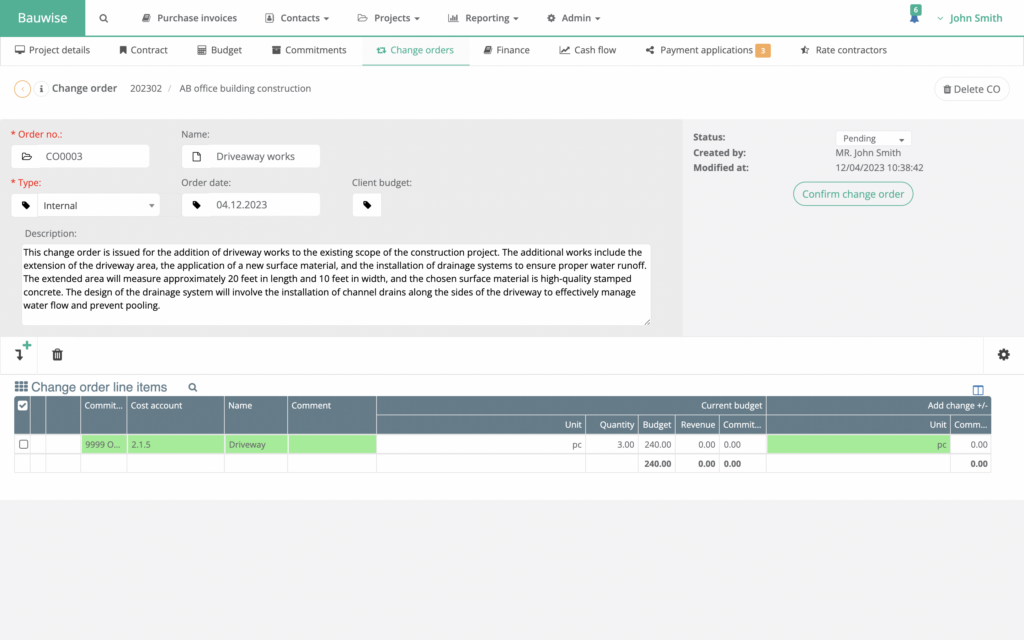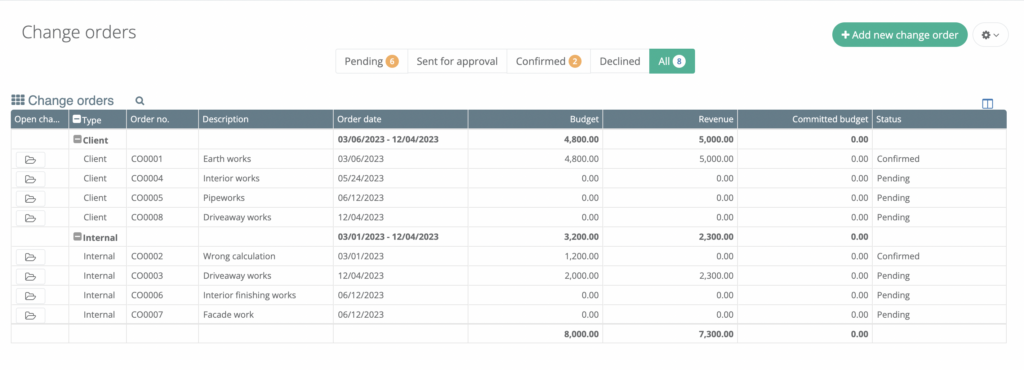Table of Contents
What is a change order?
A change order in construction is a formal agreement that documents modifications to the original construction contract. These modifications include adjusting costs, adding or reducing tasks, revising timelines, altering designs, or other deviations from the initial project plan.
Construction change order usually involves an agreement between the project owner and the general contractor or between the general contractor and a subcontractor. They jointly agree on and detail the alterations in the change order document. It updates the original contract, describing the project’s scope and referencing costs, plans, drawings, and specifications. As such, all parties must write and approve a change order, which can take time, money, and patience to complete.
Change orders are a frequent occurrence in both commercial and public construction projects. Some analyses suggest that, on average, about 35% of projects undergo at least one significant change during their lifespan. However, minimizing them as much as possible is advisable, as they often lead to project delays and increased costs.
Typically, changes in construction plans adversely affect only one party involved. For example, the project owner may need more time to open a new building, or the contractor may have to use more expensive materials without adequate compensation.
Various situations can lead to the need for change orders. Typical instances of change orders involve situations like the client wanting to adjust the position of a door for better space utilization, installing an additional skylight in a place that wasn’t originally planned, or switching the kitchen countertops from granite to marble. Such modifications are examples of additive change orders. On the other hand, there are also change orders that remove elements of the original plan. These are referred to as deductive change orders. For example, deciding against building a previously planned patio or removing a planned fireplace. Deductive change orders usually lead to a reduction in the overall cost of the contract.
Change orders are necessary for construction projects due to their ever-evolving and intricate characteristics. In many cases, it’s impractical to foresee all potential obstacles or variables at the beginning of a project. Errors or unclear details in the initial plans, the property owner’s wish to modify the design for visual appeal, and the need to cut down expenses can all lead to implementing a change order.
Common Causes of Change Orders in Construction
Construction change orders often stem from oversights or errors during the initial planning or pre-construction stages. They may also arise due to mistakes during the building process, the need for different materials, or additional client requests. Let’s delve into some key reasons for change orders in construction.
1. Estimation Inaccuracies
Construction projects use estimated calculations to plan time, resources, and budget. These estimates, rough predictions of future costs or requirements, are not always precise. During the estimation process, various questions may emerge related to design specifics, resource allocation, or budget constraints. If these issues cannot be resolved straightforwardly, it’s advisable to issue a change order to address these concerns before the project begins.
2. Execution Errors
One common reason for change orders is errors during the construction phase. Given the complex nature of construction projects, mistakes are often inevitable. Asset owners should choose general contractors to mitigate this based on their experience in similar projects. Similarly, general contractors should select subcontractors based on comparable criteria. Ensuring that all workers on a project are adequately trained and certified can significantly reduce the risk of errors. Lack of proper training or certification increases the likelihood of mistakes, delays, potential fines, or stop work orders, which can necessitate change orders.
3. Modifications in Design
In an ideal scenario, mistakes like inaccurate specifications or missing details in the initial construction plans are identified and rectified before starting the project. However, if these errors are discovered during the construction phase, they can be significant enough to necessitate a change order.
Design alterations in construction projects typically fall into two categories:
- The Asset Owner decides to alter their initial requirements or requests additional work.
- Changes to the original designs are necessary for the successful completion of the project.
While general contractors and subcontractors cannot always anticipate or manage the first type of design changes, the second type can be addressed through meticulous review and revision of project designs, drawings, and other foundational documents.
4. Fluctuating Material Costs
Long-term construction projects often face fluctuations in material prices. For example, roofing tiles that initially cost $30 per square meter at the onset of construction. By the time additional supplies are needed, the price could have risen to $45 per square meter. Add to this unforeseen enhancements like an upgraded facade or specialized outdoor fittings, and the material expenses can quickly surpass the original budget. Change orders are essential in managing these rising costs effectively, ensuring they don’t adversely affect the overall financial health of the project.
5. Unexpected Site Conditions
Unforeseen issues like foundational instability, unexpected moisture penetration, rotting wood, slow leaks, pest infestations, termite damage, or hidden mold outbreaks often surface during a construction project. On larger-scale projects, contractors might stumble upon unknown archaeological artifacts or natural obstacles like boulders. Moreover, local authorities might introduce new compliance measures based on environmental regulations or community development plans.
6. Scope Alterations by Clients
Clients frequently revise their preferences, leading to changes in design or the need for different materials, thus necessitating a change order. For instance, replacing laminate flooring with hardwood can significantly impact material costs and labor requirements. Similarly, deciding to expand a single-story structure into a two-story building can drastically change the project’s scope, budget, and schedule.
Clients and contractors must establish a financial threshold beyond which a change order becomes necessary. For example, upgrading from a basic tile to a slightly more expensive ceramic option might incur a minimal cost increase per square meter, a cost the contractor might absorb. However, more significant shifts, like switching to a high-end tile, require a formal change order to manage the additional expenses.
7. Inspection Setbacks
During construction, inspectors might identify compliance issues with building codes. For example, the fire safety measures might not meet the required standards, or there could be a need for more robust plumbing systems. Additionally, inspections can reveal issues unrelated to the main project scope. When refurbishing an office building, the inspection might uncover that the heating system is outdated and doesn’t meet current efficiency standards. Addressing these issues typically requires a change order to rectify the problems and bring the project up to code.
8. Unforeseen Circumstances
Occasionally, external factors can disrupt a construction project, necessitating change orders to adjust or remedy the situation. These disruptions could range from workforce strikes, unexpected acts of vandalism, and severe climatic conditions to catastrophic events like earthquakes or floods. Additionally, a client’s financial constraints, such as sudden budget limitations or financing issues, might require significant scaling down or modification of the project scope.
To learn how to handle change orders in construction, read the article about how to improve change order management.
Types of change orders
Contractors employ a range of change order types to work together with project owners effectively. Below are the four most frequently used categories:
1. Fixed Price Change Orders (Lump Sum)
This type of change order is used when the exact cost of a change can be determined upfront. It establishes a specific, unchanging price for the additional or altered work, providing a clear and defined cost for the scope change.
For example, in a home renovation project, a homeowner originally contracts a builder to remodel their kitchen for $20,000, with specific plans and materials outlined. Midway through the project, the homeowner decides to upgrade the countertops from laminate to granite, a change not included in the original plan. After assessing the cost, the contractor offers a fixed price change order of $3,000 for this upgrade. The homeowner agrees, and the project continues with the new specification. In the end, the kitchen is renovated with the granite countertops, and the homeowner pays a total of $23,000, which includes the original contract amount plus the fixed price for the change.
2. No-Cost Change Orders (Zero cost)
These change orders are applied when a modification in the work scope does not impact the project’s overall cost. They are used to adjust the scope of the project without altering its financial aspect, often involving changes that are neutral in terms of cost.
For example, in a landscaping project for a residential property, the homeowner and the contractor initially agree on a plan to include rose bushes and tulips in the garden for a set price. However, before the planting begins, the homeowner decides to swap the tulips for daffodils. The contractor evaluates this change and determines that the cost of daffodils is equivalent to that of tulips. Therefore, a no-cost change order is issued, simply swapping the type of flowers without any impact on the overall cost of the project. The final garden has rose bushes and daffodils, and the homeowner pays the originally agreed price.
3. Time and Materials (T&M) Change Orders
This type is utilized when the cost implications of a change in scope are uncertain or cannot be precisely estimated in advance. Under a T&M change order, the contractor agrees to track and bill for all materials, equipment, and labor costs associated with the change. This approach allows for flexibility, with billing based on the actual work and resources used.
For instance, In a home renovation, a homeowner decides to add a custom-built bookshelf to their living room, a feature not included in the original contract. Since the design is unique and the materials are not standard, the contractor cannot provide a fixed price upfront. Instead, they agree on a Time and Materials (T&M) change order. The contractor records the actual hours of labor spent designing and building the bookshelf and the cost of all materials used. Once the bookshelf is completed, the homeowner is billed for these actual labor hours and material costs. This T&M change order allows for flexibility and ensures the homeowner pays precisely for the resources and time used for the custom addition.
4. Unit Price Change Orders:
They are appropriate for changes that can be quantified into measurable units or when the total amount of work required is unpredictable. The cost is calculated based on each unit of work performed. Before confirming the change order, the contractor and the customer should negotiate and agree on the price and markup for each item and then accurately fix the quantity of work performed.
For instance, in a city park landscaping project, the contractor is asked to plant additional trees beyond the initial plan. They agree on a Unit Price Change Order, setting a price per tree planted. The final cost is determined by multiplying the number of trees actually planted by this agreed unit price, allowing for a clear and quantifiable adjustment to the project’s scope and cost.
Who prepares a construction change order?
A construction change order is prepared by the project’s general contractor or the construction manager in the construction industry. The process usually involves the following steps:
1. Identification of Change
Initially, the project owner, architect, engineer, or contractor identifies the need for a change in the project scope, schedule, or cost.
For Example: In a hotel renovation project, the hotel owner realizes that additional electrical outlets are needed in the conference rooms to better accommodate business meetings.
2. Documentation and Proposal
The contractor or construction manager then documents the change. This documentation includes a detailed description of the proposed change, the reasons for the change, and the anticipated impact on the project’s budget and timeline.
Example: The general contractor documents this requirement, outlining the details of adding electrical outlets, including the locations and the types of outlets needed, as well as the reasons for the addition.
3. Review and Approval
The documented change order is then submitted to the project owner and possibly the architect or engineer for review. These parties assess the necessity, feasibility, and potential impact of the change.
Example: This change order proposal is then submitted to the hotel owner and the project’s architect for review. They assess the impact of adding more outlets on the design, electrical load, and overall project cost.
4. Negotiation
There might be negotiations between the involved parties (owner, contractor, architect/engineer) regarding the terms, costs, and schedule adjustments of the change order.
Example: The hotel owner, contractor, and architect discuss the costs and potential schedule delays. They negotiate terms, such as the number of outlets to be added and the impact on the project’s timeline.
5. Finalization and Implementation
Once all parties agree, the change order is formally signed and authorized, making it an official part of the construction contract. The contractor then implements the changes as specified in the order.
Example: After reaching an agreement, the change order is formally signed by the hotel owner and the contractor. The contractor then proceeds to implement the addition of electrical outlets in the conference rooms as per the finalized change order.
It’s important to note that while the contractor or construction manager usually prepares the change order, it’s a collaborative process that involves input and agreement from multiple parties involved in the construction project.
What does a construction change order look like?
A construction change order typically appears as a formal document and includes several key components to define the changes to the original construction contract clearly. Here’s an example of what it looks like in construction management software:

Check out our article, where you can find and download free construction change order templates and use them as you see fit.
What should be included in a change order?
As you can see from the previous picture, a construction change order has several components. To ensure clarity, accountability, and effective communication, a change order should include the following elements:
- Change Order Number: Each change order should have a sequential number for tracking purposes. This number is crucial for maintaining records and for referencing in construction project management and financial reporting.
- Change Order Name: This provides a unique identifier or title for the change order, facilitating easy reference and organization.
- Change Order Type: Indicating the type of change order (such as Fixed Price, Time and Materials, No-Cost, or Unit Price) provides clarity on the nature of the change and the method of handling its cost implications.
- Change Order Date: The date when the change order is issued. This is important for tracking the construction project’s progress and aligning it with the project timeline.
- Description of the Change: A detailed explanation of the change being made. This should include a thorough description of the modifications to the original scope of work, providing a clear understanding of what is being altered, added, or removed.
- Status of the Change Order: The current status of the change order, such as pending, sent for approval, confirmed, or declined. This helps in monitoring the progress and approval workflow of the change order.
- Created By: Identification of the person or party who has created or initiated the change order. This could be the contractor, client, architect, or engineer, and provides accountability.
- Change Order Line Items: This is a critical component and should include:
- Cost Account: The specific budget line or cost account affected by the change.
- Unit: The measurement unit for the scope of work being changed (such as square feet, hours, etc.).
- Quantity: The amount of work, materials, or units affected by the change.
- Current Budget: The original budgeted amount for the specific work or materials before the change.
- Revised Budget: The new budgeted amount after the change, reflecting the financial impact of the modification.
Including these elements in a construction change order ensures a comprehensive and transparent approach to managing changes in a construction project. It allows all stakeholders to understand changes and their impact on project scope, schedule, and budget and maintains a documented trail of accountability and project management effectiveness. For more information on what to include in a change order, read our article: 8 Things Every Change Order Should Include.
Who signs a change order in construction?
In construction, signing a change order typically involves key parties directly impacted by or responsible for the changes. These usually include:
1. Project Owner
The owner of the construction project is a principal signatory. Their signature indicates agreement to the changes, especially if they affect the project’s scope, budget, or timeline.
2. General Contractor
The contractor responsible for executing the construction work signs the change order to confirm their commitment to carrying out the revised scope of work.
3. Architect or Engineer (if applicable)
If the change impacts the design or technical specifications of the project, the architect or engineer involved may also need to sign. Their signature would indicate that the changes comply with design standards and building regulations.
4. Construction Manager (if involved)
In projects with a construction manager overseeing the work, their signature may also be required to confirm the change order’s feasibility and impact on the project schedule.
5. Subcontractors (if affected by the change)
For changes that impact the work of subcontractors, their signatures may be necessary to confirm their agreement to the revised terms of their engagement.
The signatures on a change order serve as a formal acknowledgment and agreement from all relevant parties to proceed with the changes in the construction project as specified in the order. This process ensures transparency, mutual understanding, and clear communication, which are critical for the smooth continuation of the project.
Real-life construction change order examples
Here are some real-life examples of construction change orders:
- Addition of an Elevator in a Commercial Building: Originally, the building was designed without an elevator. However, during construction, the client decides to make the building more accessible and requests the addition of an elevator. This change order would involve significant modifications to the building’s structure, electrical and mechanical systems, and would likely increase the budget and extend the project timeline.
- Change in Flooring Material in a Residential Project: The initial plan called for hardwood flooring throughout a new residential home. Midway through the project, the homeowner opts for more expensive marble flooring in certain areas, like the entryway and bathroom. The change order would detail the cost difference, the additional time needed for installation, and any impacts on other aspects of the project.
- Historical Building Renovation Compliance: While renovating a historical building, the construction team discovers that the planned window replacements do not meet historic preservation standards. A change order is issued to source and install windows that comply with these standards, which might be more costly and require a different installation method.
- Upgraded HVAC System in an Office Building: During the construction of a new office building, the client decides to upgrade the HVAC system to a more energy-efficient model that was not initially budgeted for. This change order would cover the cost difference between the two systems and might also extend the project’s completion date due to the time required to procure and install the new system.
- Relocation of Plumbing in a Restaurant Remodel: In the middle of remodeling a restaurant, the owner decides to change the kitchen layout, requiring the relocation of major plumbing lines. This change order would involve additional plumbing work, potentially new permits, a project timeline, and cost adjustments.
- Foundation Reinforcement in a School Extension: After beginning an extension to a school, the construction team finds that the soil is not as stable as expected, necessitating additional foundation reinforcement. This would lead to a change order covering the extra work, materials, and potential delays caused by these unforeseen ground conditions.
These examples illustrate the various situations in construction projects where change orders are necessary to accommodate changes in scope, design, materials, compliance requirements, or unforeseen circumstances.
Streamline your change orders with Bauwise change order management software
Bauwise offers a user-friendly change order software that simplifies the tracking, processing, and approval of change orders. With its intuitive interface, you can easily create, modify, and manage change orders, ensuring that all modifications are accurately documented and efficiently processed. The software provides real-time updates and alerts, keeping all stakeholders informed and aligned, thus reducing delays and misunderstandings. Try Bauwise for free today!
Written by

Taavi Kaiv
Taavi Kaiv is a construction specialist with over ten years of experience in the construction industry. Taavi is an accomplished construction project manager with many successful projects that have been completed under his guidance. Taavi holds a master’s degree in construction management from the Tallinn University of Technology. View profile
Related posts
Read our articles where you can find useful and relevant information about construction change orders:





